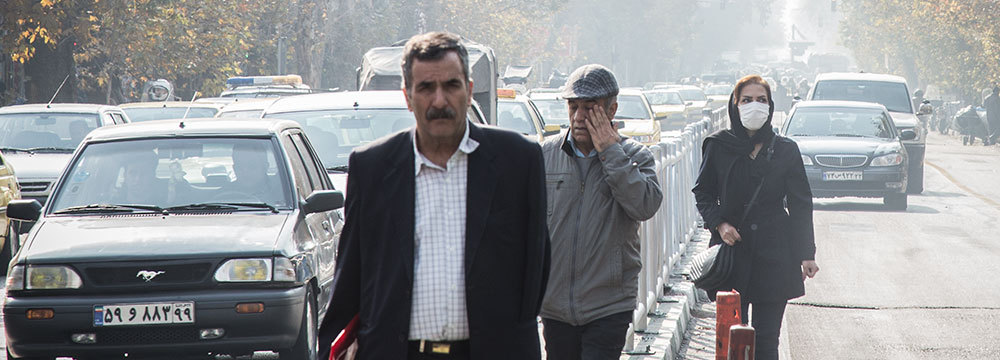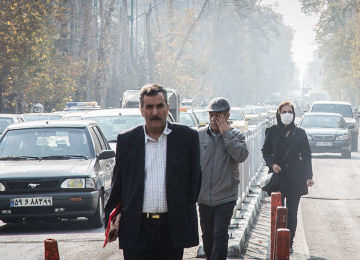Tehran experienced the poorest autumnal air quality in four years, despite measures to reduce the capital’s recurring smog in the cold season.
This has been largely blamed on ineffective policies to control the sources of pollution, particularly automotive sources that reportedly generate 80% of the pollution in metropolises.
Experts call on the government to devise a comprehensive program to bring related entities on board to tackle all the issues contributing to the chronic air pollution afflicting Iranian metropolises.
Based on data released by Tehran Air Quality Control Company, the average Air Quality Index over the past autumn stood at 99, above the average of the previous three years (94, 92 and 93).
Particulate Matters
The rise in the concentration of PM2.5 (particulate matter smaller than 2.5 micrometers) and PM10 (particulate matter with a diameter of 10 micrometers or less) were chiefly responsible for the decline in air quality with average indices measured at 99 and 73 respectively, up from 94 and 65 over the previous fall.
The PM2.5 and PM10 figures showed 92 and 55 in the autumn of 2016 and 93 and 58 in 2015 respectively.
Particulate matters are formed when gases emitted from motor vehicles and industries undergo chemical reactions in the atmosphere.
Exposure to particle pollution is a public health hazard. When inhaled, particle pollution can travel deep into the lungs and cause or aggravate heart and lung diseases.
Overall, the capital went through 43 days of unhealthy air quality, including 39 days of dangerous pollution levels for “sensitive groups”, which include children, the elderly, exercising adults and those suffering from asthma or bronchitis, and four days for all groups.
This is while the total number of unhealthy days were 30 last autumn.
In the fall of 2016 and 2015, the residents of Tehran saw 33 and 35 unhealthy days respectively.
The last week of autumn was the most dreadful, as air pollution gradually increased to reach dangerous levels that led to the closure of schools and stricter traffic restrictions.
This year’s fall concluded with the record-breaking AQI of 172 and the most polluted day of the entire year. The figures show that the pledges to help ameliorate the capital’s air pollution have either not been fulfilled or have been ineffective for some reason.

Fuel Quality
The government has been boasting about improvement in the standards of fuel distributed in metropolises, but the impact of the move has not been palpable.
The Oil Ministry started supplying Euro-4 quality gasoline and diesel fuel since 2013, first in a limited number of gas stations in Tehran and later across the whole city, as well as seven other metropolises, namely Karaj, Arak, Tabriz, Mashhad, Ahvaz, Shiraz and Isfahan.
Normally, one would expect an improvement in air quality, but that has not happened.
Mohammad Ali Ehteram, a faculty member at Shahid Beheshti University, has attributed the failure to the inefficiency of catalyst converters in vehicles.
A catalytic converter is an exhaust emission control device that converts toxic gases and pollutants in exhaust gas from an internal combustion engine to less toxic pollutants.
According to Ehteram, the device is highly sensitive to poor-quality fuel and might break down or lose efficiency with a single injection of substandard fuel.
“Euro-4 fuel is only supplied in eight metropolises and if the driver gets the car filled up in a town along a journey, the catalyst will most likely be spoilt,” he said.
Soot Filter
Although the directive that compels automakers to install diesel particulate filters on diesel vehicles has gone into effect for over a year (since October 2016), it has also failed to combat pollution.
This has been blamed on the Department of Environment’s delay in laying out the details of the law.
“The process of acquiring a permit for DPF-equipped vehicles is currently not clear and is performed based on personal discretion,” Mehdi Douzandegan, a mechanical engineer and environmental activist, said earlier.
Lack of clarity in regulations has led to a great deal of cheating as well.
According to experts, since there is no reference laboratory in Iran to test diesel-fueled vehicles, automakers obtain an initial confirmation from foreign companies with no guarantee that the requirements are met later during mass production.
Besides, several carmakers install only the shell of the filter without the inner contents and others use poor-quality DPF that wears out soon and is later replaced with common mufflers.
Two-Wheelers
Around one million motorbikes ply the streets of Tehran, many of which are equipped with carburetors that are both fuel-intensive and highly polluting.
The production of carburetor-equipped motorcycles has been banned since September 2016 following a government directive. However, the polluting two-wheelers are still traded in the market.
Knowing that the law was going into effect, certain manufacturers produced and registered a large number of carbureted motorcycles earlier to facilitate their sale in the future.
According to Abolfazl Hejazi, director of Iran Motorcycle Manufacturers’ Syndicate, 800,000 carbureted motorbikes were produced in the last fiscal year (ended March 20, 2017) while the market’s total demand was fewer than 500,000.
“Last year’s productions are still traded this year and are expected to remain in the market until the end of the year,” he told Tasnim News Agency in September.
Besides, the two-wheelers that were already in use prior to the ban will continue to ply the city’s roads until who knows when.
Although smaller than cars, motorcycles are said to be four times more polluting, because they are not equipped with catalyst converters and release all the toxic gases directly into the air.
Scrappage Scheme
The government’s directive on scrapping dilapidated vehicles, a progressive law that came into force on Sept. 17, was abolished under pressure from automakers, much to the surprise of experts and environmentalists.
The directive had obliged local automotive companies to send one old car to the junkyard for the production of each car with a fuel consumption of over 8.5 liters per 100 kilometers, or else pay 25 million rials ($625), forcing them to remove a gas guzzler from the roads.
Otherwise, license plates for high-consumption vehicles were not issued.
However, the abolition of the scrappage system has only helped worsen the city’s pollution.
The Clean Air Bill prepared by DOE was approved by the Majlis and the Guardians Council early this year and communicated to the government bodies on Aug. 9. The law’s regulations are currently being outlined and its enforcement is expected to improve Tehran’s air conditions.







Add new comment
Read our comment policy before posting your viewpoints